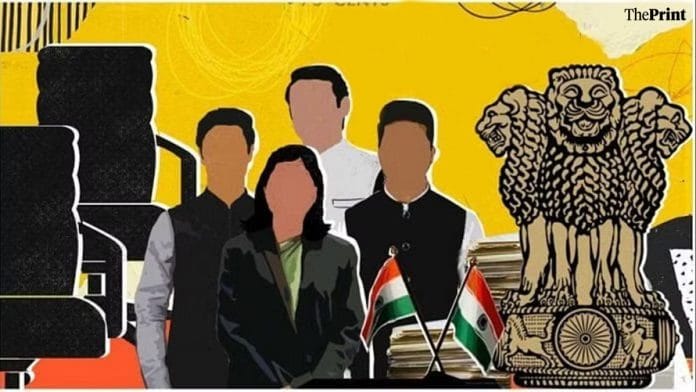Despite great interest in joining or watching the Indian Administrative Service at work, truly little is known about how the state cadres function. Even less is known about the AGMUT cadre—UT for short—the most unique of them all. It bears telling.
The trigger came last Saturday when I attended the cadre’s annual get-together. Mostly, there were serving officers currently posted in the Delhi Government or in the Central Ministries, but retired officers also attended. This year, the oldest retiree was from the 1960 batch and the youngest officer (still under training) was from the 2022 batch! Former Governors, LGs, Union Secretaries and Chief Secretaries, Principal Secretaries and administrators were all there, (now have-beens)—their only link being a common service past.
A royal welcome awaited the guests at Pallika Service Officer’s Institute, an NDMC officers’ club, set in tony Chanakyapuri, New Delhi. Officers and wives dazzled in sparkling ensembles and vibrant jackets (from the Northeast). A red carpet and a shower of rose petals welcomed the officers, along with a beautiful bandhani stole and an instant photograph, by way of mementos.
Later, the Chief Secretary, Delhi, presented retired officers with a framed plaque extolling their achievements. Meeting some of those who had worked with me as SDMs, Deputy Commissioners and Heads of Departments in Delhi and elsewhere, chuffed me no end. Those I had once trained, terrorised and hopefully nurtured, now recounted my many official follies (with much exaggeration), but that is what service warmth and camaraderie are about!
Also read: IAS officers on how they deal with politicians’ pressure. Sheila Dikshit to Mamata Banerjee
Diversity and history
What makes this cadre completely different from other state cadres is unquestionably, the diversity of the postings, distinct and individual political structures, exceptional locales, and a sense of history. Ranging from full states like Arunachal Pradesh, Goa, and Mizoram to Union Territories with legislatures, such as Delhi and Puducherry, and territories governed by an Administrator, the canvas is vast.
Each posting is unique. Arunachal Pradesh is a thickly forested mountainous expanse dotted with monasteries and the first to see sunrise in India. With 28 districts bordered by China, Bhutan, Tibet and Myanmar, and the states of Nagaland, and Assam, Arunachal has stolen a march over others by making a policy for using using drones for agriculture, health services and environmental protection.
At the opposite end of India and in stark contrast lies the tiny coastal state of Goa —a shining example of some of India’s best human development indicators. Centuries of dynastic and then the Delhi Sultanate’s rule followed by the Portuguese annexation spanning over 400 years, have left their imprint on every aspect of Goa’s language, culture, architecture, and food. Today, the population is two-thirds Hindu and one-fourth Christian and that is key to governing Goa.
Mizoram is the third full state serviced by UT cadre officers, another forested and hilly terrain in the Northeast, where the locals have no script, yet their literacy levels are among the highest in the country. The rest of India has something to learn from the truly classless society, which is the Mizo way of life!
Among the UTs with legislature, there is Puducherry often called the French Riviera of the East, where the legacy of French colonisation, including the architecture, cuisine, and lifestyle, is still in evidence.
The UTs without legislature are no less striking. They include meticulously planned Chandigarh and in complete contrast the two breathtaking archipelagos of the Andaman & Nicobar and Lakshadweep islands studded in the Indian Ocean—one in the Bay of Bengal and the other in the Arabian Sea. Add to this, Dadra & Nagar Haveli, Daman, and Diu all four former Portuguese territories ensconced within Gujarat, which since 2020 stand merged into a single Union Territory. Since the last five years, the union territories of Jammu and Kashmir plus Ladakh have also joined this lengthy list of UT postings.
But it is Delhi, where UT cadre officers spend the lion’s share of their career span. Serving a population of over 20 million, administering water supply and managing public transport in the second most populous city in the world is no joke. Where else would officers handle the running of 1,200 public schools and deliver municipal services to thousands of residential colonies? All while providing essential services to the other half of Delhi—10 million people living in unauthorised colonies, urban slums, and villages?
The presence of the President of India, the Prime Minister, Parliament, and the Supreme Court, is another point of difference from the rest of the country. So also, the vast spread of the biggest media hub in the country—ever ready to smell a story.
From the officers’ viewpoint, the best part is that the cadre controlling authority is the Ministry of Home Affairs, while in all other cadres, it is the state government. There only the CM matters but in the UT cadre, MHA decides officers’ intra-cadre postings, transfers, and promotions. Unlike state cadres, it is futile to get close to any CM or lobby for postings.
In the state cadres, officers spend most of their careers in comfortable and predictable state capitals. Not so in the AGMUT cadre, where officers must be nimble on their feet and ever ready to move. Fortunately, most friendships and associations made outside Delhi, have lasted a lifetime.
In my twilight years, I know the rolling stones in the AGMUT cadre will smoothen my life, should the need arise!
Shailaja Chandra is a retired civil servant and former secretary in the health ministry. Views are personal.
(Edited by Theres Sudeep)






